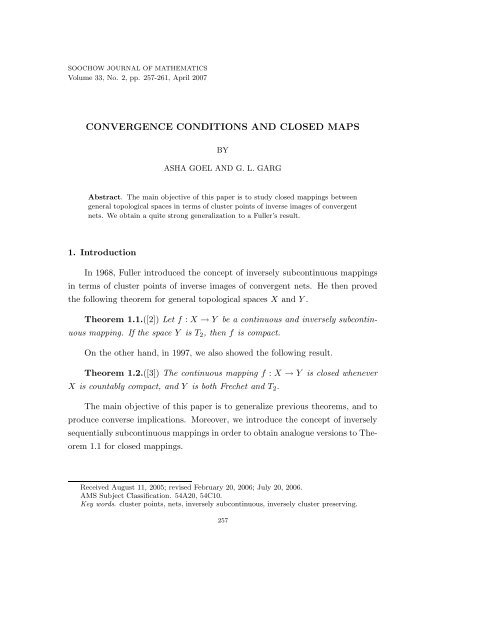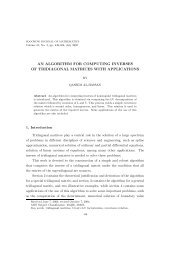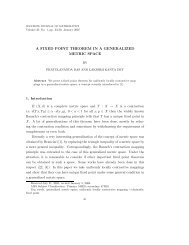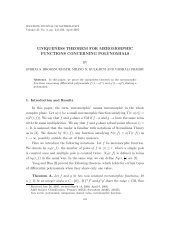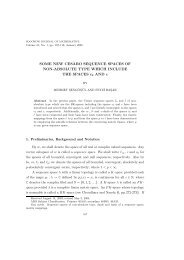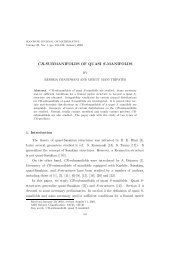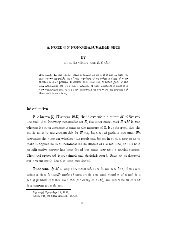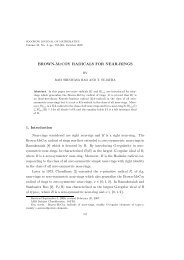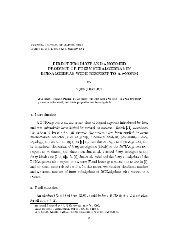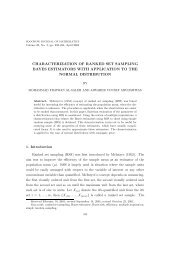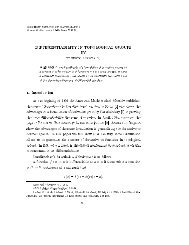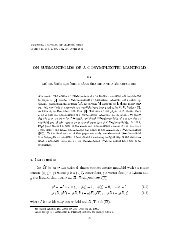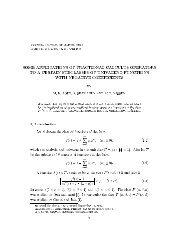convergence conditions and closed maps - Soochow Journal of ...
convergence conditions and closed maps - Soochow Journal of ...
convergence conditions and closed maps - Soochow Journal of ...
Create successful ePaper yourself
Turn your PDF publications into a flip-book with our unique Google optimized e-Paper software.
SOOCHOW JOURNAL OF MATHEMATICS<br />
Volume 33, No. 2, pp. 257-261, April 2007<br />
CONVERGENCE CONDITIONS AND CLOSED MAPS<br />
BY<br />
ASHA GOEL AND G. L. GARG<br />
Abstract. The main objective <strong>of</strong> this paper is to study <strong>closed</strong> mappings between<br />
general topological spaces in terms <strong>of</strong> cluster points <strong>of</strong> inverse images <strong>of</strong> convergent<br />
nets. We obtain a quite strong generalization to a Fuller’s result.<br />
1. Introduction<br />
In 1968, Fuller introduced the concept <strong>of</strong> inversely subcontinuous mappings<br />
in terms <strong>of</strong> cluster points <strong>of</strong> inverse images <strong>of</strong> convergent nets. He then proved<br />
the following theorem for general topological spaces X <strong>and</strong> Y .<br />
Theorem 1.1.([2]) Let f : X → Y be a continuous <strong>and</strong> inversely subcontinuous<br />
mapping. If the space Y is T 2 , then f is compact.<br />
On the other h<strong>and</strong>, in 1997, we also showed the following result.<br />
Theorem 1.2.([3]) The continuous mapping f : X → Y is <strong>closed</strong> whenever<br />
X is countably compact, <strong>and</strong> Y is both Frechet <strong>and</strong> T 2 .<br />
The main objective <strong>of</strong> this paper is to generalize previous theorems, <strong>and</strong> to<br />
produce converse implications. Moreover, we introduce the concept <strong>of</strong> inversely<br />
sequentially subcontinuous mappings in order to obtain analogue versions to Theorem<br />
1.1 for <strong>closed</strong> mappings.<br />
Received August 11, 2005; revised February 20, 2006; July 20, 2006.<br />
AMS Subject Classification. 54A20, 54C10.<br />
Key words. cluster points, nets, inversely subcontinuous, inversely cluster preserving.<br />
257
258 ASHA GOEL AND G. L. GARG<br />
2. Preliminaries<br />
Along this paper, the term space means a general topological space. No<br />
separation axioms are assumed <strong>and</strong> no mapping is assumed to be continuous or<br />
onto, unless it is mentioned explicitly. The notation cl(A) st<strong>and</strong>s for the closure<br />
<strong>of</strong> the subset A in the space X. Besides, sequences <strong>and</strong> nets are respectively<br />
denoted by the symbols {x n } <strong>and</strong> (x α ), <strong>and</strong> their <strong>convergence</strong> to a point x is<br />
then denoted by {x n } → x <strong>and</strong> (x α ) → x, respectively.<br />
A space X is said to be Frechet if any <strong>closed</strong> subsets <strong>of</strong> X can be defined by<br />
sequences. That is, for each subset A <strong>of</strong> X, a point x lies in the cl(A) if <strong>and</strong> only<br />
if there exists a sequence {x n } in A which converges to x. A point y is said to be<br />
a cluster point <strong>of</strong> a sequence or net (or accumulation point in the terminology <strong>of</strong><br />
Dugundji [1]) if the point y lies in the closure <strong>of</strong> that sequence or net.<br />
On the other h<strong>and</strong>, given any mapping f : X → Y between two spaces X<br />
<strong>and</strong> Y , we say that:<br />
(i) f is compact ([2]), if the inverse image f −1 (K) is compact for every compact<br />
subset K ⊂ Y .<br />
(ii) f is perfect ([3]), if it is continuous, <strong>closed</strong> <strong>and</strong> has compact fibers f −1 (y),<br />
for each point y ∈ Y .<br />
(iii) f is inversely subcontinuous ([2]), if any net (x α ) has a cluster point in X,<br />
whenever its image (f(x α )) converges to a point in Y .<br />
(iv) f is inversely cluster preserving, if for any net (x α ) whose image (f(x α ))<br />
converges to a point y in Y , the inverse fiber f −1 (y) meets the cl((x α )).<br />
That is, there exists at least one point x in the fiber f −1 (y) which is a<br />
cluster point <strong>of</strong> (x α ).<br />
We also introduce the definitions inversely sequentially subcontinuous <strong>and</strong><br />
inversely sequentially cluster preserving, by considering sequences {x n } instead<br />
<strong>of</strong> nets (x α ) in previous definitions (iii) <strong>and</strong> (iv) above.<br />
Remark 2.1. It can be easily proved that a mapping f : X → Y is <strong>closed</strong><br />
whenever the following condition holds: For any net (x α ) whose image (f(x α ))<br />
converges to y in Y , there exists a point x in the inverse fiber f −1 (y) such that<br />
(x α ) → x. Moreover, if the space Y is Frechet, we can use sequences {x n } instead<br />
<strong>of</strong> nets (x α ) in previous statement.
CONVERGENCE CONDITIONS AND CLOSED MAPS 259<br />
Remark 2.2. Obviously, every inversely cluster preserving mapping f is<br />
both inversely subcontinuous <strong>and</strong> inversely sequentially cluster preserving. Besides,<br />
inversely subcontinuous implies inversely sequentially subcontinuous. And<br />
every mapping with compact (resp. countable compact) domain is inversely subcontinuous<br />
(resp. inversely sequentially subcontinuous).<br />
3. Main Results<br />
The following two theorems are the main contribution <strong>of</strong> this paper. In<br />
particular, Theorem 3.2 is a strong generalization to Fuller’s Theorem 1.1.<br />
Theorem 3.1. A mapping f : X → Y between arbitrary spaces is compact<br />
<strong>and</strong> <strong>closed</strong> if <strong>and</strong> only if it is inversely cluster preserving.<br />
Pro<strong>of</strong>. We firstly prove that f is compact. Thus, let B a compact subset<br />
<strong>of</strong> Y , <strong>and</strong> (x α ) be any net in the inverse image f −1 (B). Notice that (f(x α )) is<br />
also a net in the compact set B, so it must have a cluster point y ∈ B. The fact<br />
that f is inversely cluster preserving implies there exists x ∈ X which is a cluster<br />
point <strong>of</strong> (x α ), <strong>and</strong> such that f(x) = y. That is, the net (x α ) has a cluster point<br />
x ∈ f −1 (B), <strong>and</strong> so f −1 (B) is a compact set <strong>and</strong> f is a compact mapping.<br />
Now, we prove that f is <strong>closed</strong>. Let F be a <strong>closed</strong> subset <strong>of</strong> X, <strong>and</strong> y ∈<br />
cl(f(F)). Then there exists a net (x α ) in F whose image (f(x α )) converges to<br />
y. Since f is inversely cluster preserving, there exists x ∈ X which is a cluster<br />
point <strong>of</strong> (x α ), <strong>and</strong> such that f(x) = y. The fact that F is <strong>closed</strong> implies that<br />
both x ∈ F <strong>and</strong> y ∈ f(F). Hence, f(F) is a <strong>closed</strong> set <strong>and</strong> f is a <strong>closed</strong> mapping.<br />
Conversely, suppose that f is <strong>closed</strong> <strong>and</strong> the fiber f −1 (y) is compact for every<br />
point y ∈ Y . Besides, let (x α ) be any net in X whose image (f(x α )) converges<br />
to a point y in Y . The fact that f is <strong>closed</strong> implies that y ∈ f(X). Now, if no<br />
point <strong>of</strong> the inverse fiber f −1 (y) is a cluster point <strong>of</strong> the net (x α ), then for each<br />
z ∈ f −1 (y) there exists an open neighborhood U(z) <strong>of</strong> z <strong>and</strong> an index α(z) such<br />
that x α /∈ U(z) for every α > α(z). Notice that {U(z) : z ∈ f −1 (y)} is an open<br />
cover <strong>of</strong> the compact set f −1 (y). Therefore, the inverse fiber f −1 (y) is contained<br />
⋃<br />
in the union U = n U(z j ), for a given definite set {z j }; <strong>and</strong> so there exists an<br />
j=1<br />
index α 0 such that x α /∈ U for every α > α 0 . Notice that y lies inside the open set
260 ASHA GOEL AND G. L. GARG<br />
V = Y \f(X\U), <strong>and</strong> f(x α ) /∈ V for every α > α 0 , because f is a <strong>closed</strong> mapping<br />
<strong>and</strong> f −1 (y) is contained in the open set U. Previous statement is a contradiction<br />
to the hypothesis that (f(x α )) converges to y. Thus, there exists at least one<br />
point x in f −1 (y) which is a cluster point <strong>of</strong> (x α ), <strong>and</strong> so f is inversely cluster<br />
preserving.<br />
The following theorem is a very strong generalization to Fuller’s Theorem 1.1.<br />
We use the same hypothesis as that <strong>of</strong> Fuller, but we prove that the mapping f<br />
is perfect, <strong>and</strong> we also get the converse implication.<br />
Theorem 3.2. Let f : X → Y be a continuous mapping defined from the<br />
general space X into a T 2 space Y . The mapping f is perfect if <strong>and</strong> only if f is<br />
inversely subcontinuous.<br />
Pro<strong>of</strong>. Suppose that f is perfect, then we can prove that f is inversely<br />
cluster preserving following the last section in the pro<strong>of</strong> <strong>of</strong> Theorem 3.1; <strong>and</strong> so<br />
f is inversely subcontinuous as well.<br />
On the other h<strong>and</strong>, suppose that f is inversely subcontinuous. We only need<br />
to show that f is inversely cluster preserving, in order to conclude that f is <strong>closed</strong><br />
<strong>and</strong> compact, according to Theorem 3.1; <strong>and</strong> so f is perfect. Let (x α ) be any net<br />
in X whose image (f(x α )) converges to a point y in Y , then (x α ) has at least a<br />
cluster point x in X, because f is inversely subcontinuous. Now, the fact that<br />
f is continuous implies that f(x) is also a cluster point <strong>of</strong> (f(x α )). Since, the<br />
space Y is T 2 <strong>and</strong> (f(x α )) converges to y, we have that y = f(x). Thus, the<br />
continuous function f is inversely cluster preserving, <strong>and</strong> so it is <strong>closed</strong>, compact<br />
<strong>and</strong> perfect.<br />
Finally, recalling that <strong>closed</strong> subsets in a Frechet space can be defined via<br />
sequences, we can prove the following result.<br />
Theorem 3.3. Let X be an arbitrary space, <strong>and</strong> Y be Frechet. The mapping<br />
f : X → Y is <strong>closed</strong> whenever it is inversely sequentially cluster preserving.<br />
Pro<strong>of</strong>. We show that f is <strong>closed</strong> following step by step the pro<strong>of</strong> <strong>of</strong> Theorem<br />
3.1, we only need to work with sequences instead <strong>of</strong> nets.<br />
Finally, the following theorem is a generalization <strong>of</strong> our Theorem 1.2.
CONVERGENCE CONDITIONS AND CLOSED MAPS 261<br />
Theorem 3.4. Let X be an arbitrary space, <strong>and</strong> Y be a Frechet T 2 space. The<br />
mapping f : X → Y is <strong>closed</strong> whenever it is inversely sequentially subcontinuous.<br />
Pro<strong>of</strong>. In view <strong>of</strong> Theorem 3.3, we only need to prove that f is inversely<br />
sequentially cluster preserving, in order to conclude that f is <strong>closed</strong>. We can<br />
easily prove this fact by following step by step the pro<strong>of</strong> <strong>of</strong> Theorem 3.2, we only<br />
need to work with sequences instead <strong>of</strong> nets.<br />
Acknowledgments<br />
The authors are thankful to the referee for giving valuable comments.<br />
References<br />
[1] J. Dugundji, Topology, Allyn <strong>and</strong> Bacon, Boston, Mass., 1966.<br />
[2] R. V. Fuller, Relations among continuous <strong>and</strong> various non-continuous functions, Pacific J.<br />
<strong>of</strong> Math., 25(1968), 495-509.<br />
[3] G. L. Garg <strong>and</strong> Asha Goel, On <strong>maps</strong>: Continuous, <strong>closed</strong>, perfect, <strong>and</strong> with <strong>closed</strong> graph,<br />
International <strong>Journal</strong> <strong>of</strong> Math. <strong>and</strong> Math. Sci., 20:2(1997), 405-408.<br />
[4] A. Wilansky, Topology for Analysis, Xerox College Publishing, Toronto, 1970.<br />
Department <strong>of</strong> Applied Sciences, Punjab Engineering College (Deemed University), Ch<strong>and</strong>igarh<br />
– 160 012, India.<br />
E-mail: ashagoel30@yahoo.co.in<br />
Department <strong>of</strong> Mathematics, Punjabi University, Patiala – 147 002, India.


